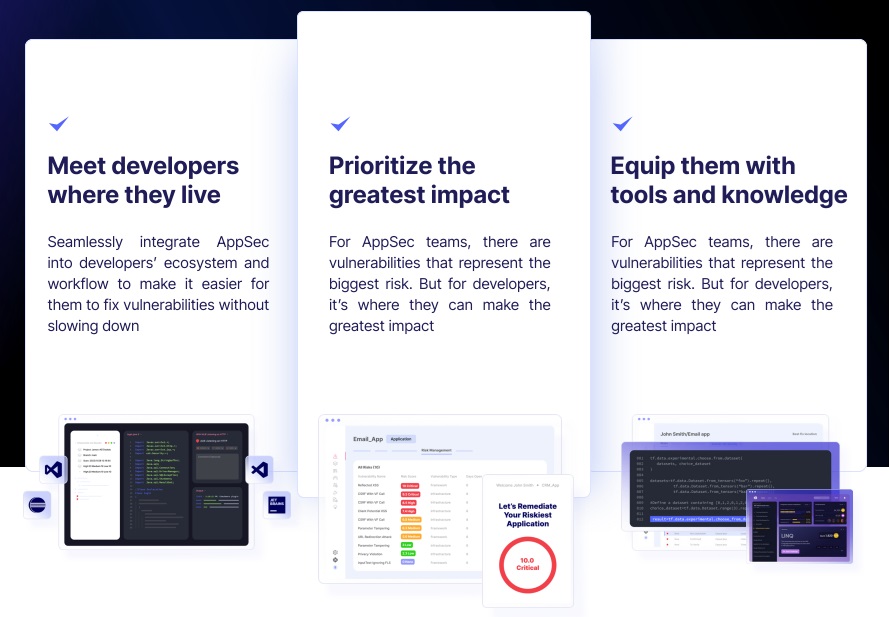
Application security is a term that covers all of the activities, processes, tools and technology that secures the software development lifecycle (SLDC). By implementing application security features and technologies into the way that teams work, DevSecOps teams can identify, understand, and mitigate security issues within their applications, anywhere from the earliest build stages to runtime.
Why are AppSec Tools Important?
Application security tools, (sometimes shortened to AppSec tools) are a critical way to protect applications, and in turn – these applications are crucial to today’s enterprises. 77% of CISOs said that over half of their revenue comes from applications they are responsible for securing, and yet 92% had experienced a breach over the last year because one of their deployments was vulnerable. AppSec tools, and perhaps more importantly, the right AppSec tools are an integral part of business success.
Today, teams are generally looking for AppSec tools that are able to:
- Consolidate multiple technologies into one platform: Tool sprawl is a growing issue in the security world, and 90% of teams are using three or more tools to detect and prioritize vulnerabilities in their code. The need to find a ‘single pane of glass’ for application security to improve visibility and mitigation is one of the top drivers of adopting a comprehensive application security platform.
- Improve developer experience and provide autonomy: Traditionally, AppSec teams are responsible for finding security issues and vulnerabilities, and developers are the ones putting the fix into place. This can cause friction between the two, and 67% of developers say they would like to receive their scan results directly in the Integrated Development Environment (IDE) to keep their workflow intact. Today’s AppSec tools can make that happen.
- Offer quick time to value: AppSec teams are usually heavily outnumbered against development teams, so it’s critical that application security platforms have a short learning curve when it comes to implementation, integration and fine-tuning to the organizational workflow. Many AppSec tools just aren’t showing enough ROI, leaving organizations looking for more modern or effective alternatives.
Top 8 Application Security Features
When you’re looking to adopt a comprehensive application security solution – what are the must-haves? AppSec 2024 is a dynamic and fast-changing environment to contend with, but a good baseline for any AppSec tools should include:
- SAST: Static Application Security Testing allows you to conduct fast and accurate scans in your source code, byte code, or application binaries to uncover security vulnerabilities, compliance issues, and business risk. This happens before the code is compiled, at the earliest stages.
- DAST: Dynamic Application Security Testing looks for vulnerabilities that could allow an attacker to breach your environment once code has already been deployed. By testing against a wide array of web application attacks, these can be found and fixed ahead of time.
- SCA: Software Composition Analysis identifies security risks and vulnerabilities in any open-source software that is used in your applications. All open-source components and packages are scanned, allowing developers to move fast and utilize open-source libraries, without opening the business up to risk.
- Container security: Container images can also open applications up to the risk of attack. Your application security platform should be able to scan static container images, check configurations, and identify issues with open source packages pre-production.
- SSCS: Gartner predicts that by 2025, 45% of companies will have experienced an attack on their software supply chain. Software supply chain security simplifies the generation of a Software Bill of Materials (SBOM), and includes features such as open-source package scanning and secrets detection.
- IAC security: Vulnerabilities and misconfigurations in IAC files can open your business up to risk, including poor secrets management, configuration drift, user privilege vulnerabilities, and insecure open-source components. IAC security uses thousands of predefined queries to find and fix issues ahead of time.
- API security: Most companies struggle with shadow and zombie APIs, where APIs are adopted without the knowledge of the organization, or have become disused or deprecated but are still available. API security compares your entire API inventory to your API documentation, so you have full visibility at all times.
- Runtime security: By correlating pre-production data with runtime insights, organizations can secure applications while they are running in production. This category of AppSec features help with prioritization – recognizing where limited resources need to be spent to ensure the most critical issues are fixed first and foremost.
Key Considerations for Choosing Effective Application Security Tools
When shopping around for application security, it’s not enough to have all the boxes checked. There are a number of important considerations that take your application security from being technically proficient to actively reducing risk and adding visibility for ROI.
First, the ability to correlate results across different AppSec tools, for example across SAST and SCA is an important differentiator. By aggregating data into a single view, your organization obtains a more accurate understanding of which applications are opening the business up to the greatest risk, and can prioritize better across teams.
This feeds into the idea of exploitability – a metric that your application security tools should be able to visualize for you. Rather than be provided with a list of vulnerabilities, all weighted equally, can your security platform recognize what’s truly exploitable, and in turn what doesn’t impact you? For example, a library of functions where some are insecure is only a problem if you’re leveraging those functions. While best practice is to update or replace all vulnerabilities, we know that in reality it’s often a matter of prioritization.
Finally, another consideration is the importance of runtime protection. We’ve found that 40% of the vulnerabilities that AppSec teams discover occur in production, so it’s crucial to be able to connect the dots between your pre-production data and what’s happening after deployment.
Trends In AppSec 2024, Delivered by Checkmarx One
Checkmarx One is a complete application security solution which covers all of the must-have application security features in one unified, consolidated security platform. It supports organizations in correlating and prioritizing results for a complete and accurate view, and offers unparalleled control over a complex enterprise environment. At the cutting edge of the industry, we offer best practices for:
- Cloud: Fully integrated into the cloud, Checkmarx One provides ultimate flexibility for scanning any application, including offering private cloud and on-premises deployments for where security dictates the need, role-based access control, and complete scalability. Our ‘code to cloud’ approach means you have all the tools you need to secure every stage in the SDLC.
- Customization: We believe that your security should be tailored to the application, not the other way around. Checkmarx One allows you to fine-tune your AppSec controls to meet each application’s needs, including offering customizable rules, customizable rulesets, and our AI query builder – which allows even teams without AppSec experience to tailor security coverage to an application.
- Reporting: At Checkmarx, we recognize that your teams need to be able to visualize everything – and quickly. A unified and configurable dashboard correlates results across tools and provides a single view, while executive summaries pull out the headlines to make reporting upwards easier than ever. Your notifications and alerts arrive through your existing communication tools, and you can easily download, export and consume data in a wide range of formats to use elsewhere.
- Developer experience: The relationship between AppSec and development teams is one of our top priorities. Checkmarx One meets developers where they are, with scan results delivered directly in the IDE, CLI agents for key platforms, direct integration with the repo, and comprehensive language and framework support. It is compiler-agnostic, includes an integrated feedback tool, and allows developers to utilize GenAI plugins to leverage the latest AI innovations.
Today’s application security teams are being pulled in dozens of different directions, and are continually being asked to do more with less. Checkmarx One is a single unified platform that includes everything you need to secure your applications from the very first line of code to runtime, across every stage of the SLDC. It prioritizes the developer experience, provides complete visibility by correlating results across tools, and allows you to fine-tune the solution so that your efforts will equate to the greatest business impact.
See how it works for yourself by scheduling a demo of Checkmarx One.
